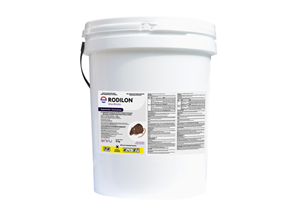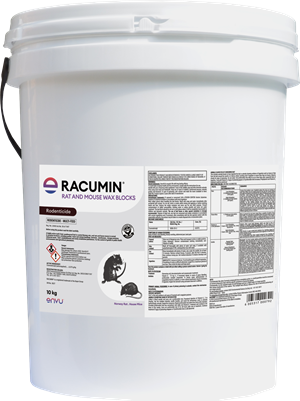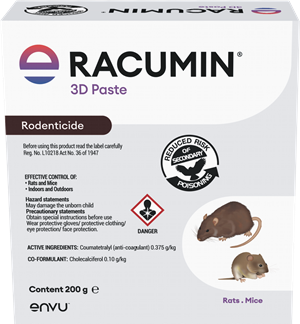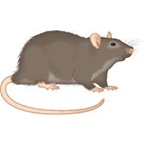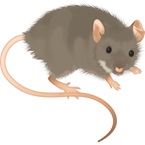Order: Rodentia
Family: Muridae
Norway Rat: 220-260mm long
CHARACTERISTICS:
Brownish or greyish rodents with a tail approximately as long as the body. Omnivorous, often live in or around buildings.
SPECIES CHARACTERISTICS:
Norway Rat (Rattus norvegicus)
Common names are Norway rat, Common rat and Brown rat. Adults: 220-260mm long; tail length 160-200mm; weight 150-450g; droppings are approx 20mm long. Upper brown body with a white, yellowish belly.
AREAS WHERE FOUND:
Norway Rat (Rattus norvegicus) - The Norway rat originated from Central to East Asia. It is thought to have arrived in Europe later than the Black rat, c. 16-17th century.
IMPORTANCE AS A PEST:
Human health: Carriers of over 45 types of diseases including spirochaetes causing Weil’s Disease (Leptospirosis), Salmonella, E.coli, enteritis, listeriosis, rickettsiosis, dysentery and many others. Contamination of water and food. Contamination of environment
Construction: Damages in buildings: In sewers, dikes etc., in electric facilities & cables and in communication.
Direct food losses: Field crop losses. Stored food and food prod. chain losses.
Indirect food losses: Packaging destruction, spillage. Contamination with faeces.
Animal production: Feed losses and spillage. Vector and reservoir of pathogens.
LIFE-CYCLE:
Norway Rat (Rattus norvegicus):
The Norway rat reaches sexual maturity in about 2-3 months and are reproductive for one year. Norway rats can breed throughout the year if conditions are suitable. The gestation period is only 21 days and a female can produce up to a maximum of five litters a year. 14 pups per litter is the maximum, although six is the average.
CONTROL:
An integrated pest management approach using a combination of control measures (e.g. improving hygiene, proofing) is necessary in order to gain control of a rodent infestation. Baiting alone is not sufficient. To effectively control rat and mouse problems there are six golden rules which should be followed:
Inspection / Assessment of infestation
A thorough survey of the infested site before treatment begins is an essential key to success when using any rodenticide. It is important to determine the exact source of the infestation so that the problem can be tackled at source. Typical signs of an infestation are the smudge marks left by a rodent’s oily hair, its droppings and any damage to goods or structures. Draw up a simple site plan or location list identifying areas of particular concern pertinent to the site and retain this on file.
- Identification:
By observing the rodent's identifying characteristics and by inspecting its droppings, you will know which of the three typical species you are dealing with and will then be able to focus on the correct tactics to eliminate the problem. Mice and rats have significantly different behaviour patterns and need to be controlled differently.
- Sanitation:
Removing the rodent's food sources is a key factor in successful rodent control. Garbage, food or feed should be stored in sealed containers. Outside debris and vegetation, particularly where it is in contact with buildings, should be removed. In addition try to reduce the number of extraneous water sources where rodents are able to drink such as ditches, stagnant pools, fountains and ponds, etc.
- Rodent proofing:
Keeping rodents out of buildings by closing off the typical places where they can gain access, is a key factor in successful rodent control. For example, close all holes in exterior walls, screen downpipes in gutter top and bottom and install self-closing devices on doors that are frequently used.
- Apply an effective rodenticide:
The use of poison baits has proved to be the most cost effective option developed so far in eliminating rodents. The use of bait dispensers are strongly recommended to keep bait fresh and prevent accidental ingestion by non-target animals. Finale® and Racumin® are the bait solutions to your rat problem wherever it occurs. The feeding habits of rats and mice differ. Rats tend to eat at familiar places and need 15-30 ml water daily. They tend to feed for longer at a given place than mice. Mice nibble at food for a while, move on to the next place, nibble again and move on again. They get most of their water from food. This difference in feeding habits, require different methods of placing the bait. For rats, the bait must be placed next to walls, boxes, etc. next to their pathways. Less bait areas are needed, but more bait per station is needed than when mice are controlled. For mice, various bait stations must be placed with small amounts of bait at various places. Always ensure that the bait is placed out of reach of children and animals other than rats and mice. Always place bait in a secure bait station to avoid primary poisoning of non-target animals & humans.

